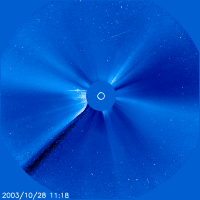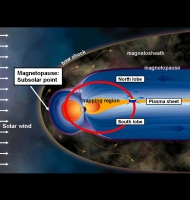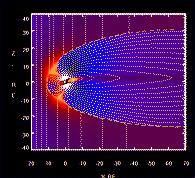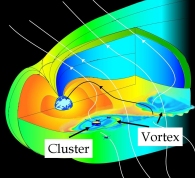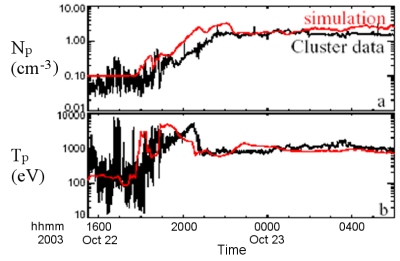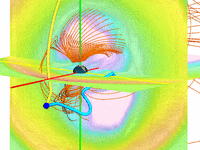Calming Effect of a Solar Storm
28 April 2005
Published 28 April 2005 in Geophysical Research Letters, two papers, based on Cluster multipoint observations, address the fundamental question of how solar wind enters the Earth's magnetotail when the Interplanetary Magnetic Field is strongly northward oriented. With this orientation, the Earth's magnetic field should act as a barrier against solar wind material. Different solar wind transfer processes have been identified in the past, but which is the dominant one? Quantitative comparison of global simulation of the Earth's magnetosphere dynamics with Cluster data, recorded during the Halloween 2003 solar storms period, shows that magnetic reconnection in the cusp regions can be the dominant process.
The largest solar flare events ever recorded by spacecraft (for a definition of solar flare classes please see the link on the right-hand side) occurred between mid-October 2003 and early November 2003 (Animation 1). Some of these events were directed towards the Earth and their effects were many.
To name a few, radio blackouts disrupted communications; solar protons penetrated Earth's upper atmosphere, exposing astronauts and some air travellers to radiation doses equal to a medical chest X-ray; auroras occured in places such as Spain and Florida.
In space, around 60% of NASA's Earth and space science missions experienced some effects from the solar activity, including the two Mars Exploration Rovers. Large effects on the magnetic field configuration around the Earth were observed and have been studied since.
Published today, 28 April 2005, a special issue of Geophysical Research Letters (GRL) gathers findings on the Halloween 2003 solar storms (GRL special issue: "Solar Storms October/November 2003").
Inside this special issue, two papers, based on Cluster data, focus on how solar material enters the Earth's magnetotail (Image 1) during a period of strongly northward Interplanetary Magnetic Field (IMF). But what is so special with this IMF configuration?
The Earth's magnetic field is our line of defence against the permanent flow of particles coming from the Sun: the solar wind. Thanks to the Earth's magnetic field, most of this solar material gets deflected and does not reach the Earth's environment.
The solar wind also carries the Sun's magnetic field lines throughout the Solar system: the Interplanetary Magnetic Field. Sometimes this magnetic field is aligned with the Earth's and sometimes it points in the opposite direction.
The Earth's magnetic field is oriented from South to North at the magnetopause subsolar point. Therefore, when the IMF is strongly southward, the Earth's magnetic field is anti-parallel to the IMF at the subsolar point of the magnetopause (Image 1). In this configuration, Earth's field lines can spontaneously break and join themselves to the Sun's (Animation 2). The solar wind then drags the reconnected field lines from the dayside to the nightside, allowing the plasma to pour into the tail of the magnetosphere.
This process, known as magnetic reconnection, is considered to be the most efficient mechanism for solar material to penetrate the Earth's magnetic shield. It requires the IMF and the Earth's magnetic field to point in opposite directions. Therefore, southward IMF together with the occurrence of magnetic reconnection implies an increase of plasma density in the magnetosphere.
When the IMF is northward oriented, it points in the same direction as the Earth's magnetic field at the magnetopause subsolar point. In this case, no or little dayside reconnection occurs. The density in the tail of the magnetosphere (or plasma sheet) should therefore logically decrease. However, the plasma sheet often becomes denser and colder for periods of northward IMF and quiet geomagnetic conditions [Terasawa et al., 1997]. How is that possible?
One logical explanation would be that this plasma is not of solar origin but instead is internal to the magnetosphere.
A phenomenon, known as ionospheric outflow, could indeed be the source of this cold plasma detected. Decades of ground-based and space observations have shown that, at auroral and polar latitudes, the F2 layer of the Earth's ionosphere does provide a significant source of magnetospheric plasma; the F2 layer is located between altitudes of 140 km and 1000 km. The cold oxygen ion (O+) is a characteristic component of these outflowing beams (several mechanisms can lead to these upward ion flows).
However, ionospheric outflows have been found to be strongest during perturbed geomagnetic conditions and southward IMF. Additionally, based on Cluster measurements [e.g., Rème et al., 2001], a cold O+ component is generally absent when the spacecraft cross the cold and dense plasma sheet. Therefore, when the IMF is northward, the plasma entering the plasma sheet is believed to be primarily of solar wind origin.
Last summer, a paper published in the journal Nature [Hasegawa et al., 2004] showed, for the first time, observations of rolled-up Kelvin-Helmholtz vortices on the duskside flank of the magnetopause, during northward IMF, thanks to the multipoint measurements of the four Cluster spacecraft (Image 2).
Kelvin-Helmholtz instabilities on the flank magnetopause are one of the physical processes that lead to solar wind plasma entry into the Earth's magnetosphere during a northward IMF period. But there are other ways for the solar wind to enter during a northward IMF period, for example viscous interaction and cusp reconnection. All these three mechanisms have now been observed, the question is: which is the dominant one?
Which solar wind transfer process dominates during northward IMF?
One way to answer this question is to compare a global simulation of the magnetosphere with local spacecraft measurements in the magnetotail, during northward IMF periods. In case of good agreement between the global simulation and the data at the spacecraft location, by analysing the numerical simulation results, one can determine which process is dominant.
However, in the case of cold-dense plasma sheet formation, model-data comparison is difficult. The formation could take several hours after northward IMF turning, during which the solar wind and IMF parameters typically vary substantially.
In other words, to make the study of solar wind entry during northward IMF convincing, one needs:
- a prolonged period of purely northward IMF under stable solar wind conditions
- spacecraft in the magnetotail
- global simulation and comparison with data at the spacecraft location
Cluster observations quantitatively reproduced by numerical simulations of the magnetosphere
During the 2003 Halloween storms, an interplanetary magnetic cloud event provided an exceptionally long period of more than 30 hours of stable solar wind conditions with a nearly purely northward IMF. Meanwhile, the four Cluster spacecraft were in the tail, observing a gradual transition from a "normal" hot and tenuous plasma sheet to a cold and dense plasma sheet, as a result of the IMF turning and staying northward.
Careful analysis of in situ observations of the solar wind (ACE), plasma sheet (Cluster) and other regions of the magnetosphere (FAST and DMSP) led to the conclusion that reconnection in the northern and southern cusps can produce the cold and dense plasma sheet.
"It took three hours for the plasma sheet to reach a stable cold and dense state after the northward turning of the IMF reached the front side of the magnetopause. Here we have shown that cusp reconnection naturally produces this delay", wrote Dr. Marit Øieroset, scientist at the Space Science Laboratory, University of Berkeley, USA and lead author of this analysis, published 28 April 2005 in the GRL special issue on Solar storms 2003.
Another group of collaborating scientists, led by Wenhui Li and Jimmy Raeder (University of New Hampshire, USA), simulated this event using their Open Geospace General Circulation Model (OpenGGCM) with measured solar wind parameters from ACE as input. They found remarkable quantitative agreements with plasma and magnetic field data at the Cluster location (Image 3). As one can notice on Image 3, this global simulation is able to not only reproduce the final cold and dense state of the plasma sheet but also the gradual transition from the hot and tenuous state to the cold and dense state.
In this global simulation, the cold-dense plasma sheet is composed of solar wind plasma coming from the magnetosheath and convected into the tail, via reconnection in both cusps; as suggested by previous theoretical work [Song and Russell, 1992]. The solar wind origin of this plasma is in agreement with Cluster and other spacecraft observations.
"Our simulation shows that cusp reconnection and the associated capture of magnetosheath plasma is sufficient to produce a cold dense plasma sheet" (Animation 3), wrote Wenhui Li, PhD student at the Space Science Center, University of New Hampshire, Durham, USA and lead author of one of the two articles, published 28 April 2005 on this subject in GRL.
No evidence of Kelvin-Helmholtz waves at the dayside or flank magnetopause, nor viscous interaction, was found in this simulation. Future studies, with higher numerical resolution, shall further help to estimate the possible contributions of these other solar wind transfer processes.
Another remaining issue is to determine if the cold-dense plasma sheet can still be formed by cusp reconnection under BY dominated northward IMF conditions.
"It is interesting to note that when one thinks of the 2003 solar storms, one thinks of strong geomagnetic activities. But when the IMF is strongly northward in the CME (or magnetic cloud), the magnetosphere can be extremely quiet. The flow speed in the plasma sheet, which can reach hundreds of kilometres per second (see December 2004 Cluster top story on Spatial scale of high speed flows in the magnetotail) is according to Cluster measurements close to 0 for 30 hours! So the solar storm can have an extreme calming effect depending on the IMF orientation. But even during these extreme quiet conditions, there is substantial entry of solar wind into Earth's magnetosphere", commented Dr Tai Phan, scientist at SSL, University of Berkeley, USA and co-author of both papers.
Øieroset, M., J. Raeder, T. D. Phan, S. Wing, J. P. McFadden, W. Li, M. Fujimoto, H. Rème, and A. Balogh (2005), Global cooling and densification of the plasma sheet during an extended period of purely northward IMF on October 22-24, 2003, Geophys. Res. Lett., 32, L12S07, doi:10.1029/2004GL021523.
Li, W., J. Raeder, J. Dorelli, M. Øieroset, and T. D. Phan (2005), Plasma sheet formation during long period of northward IMF, Geophys. Res. Lett., 32, L12S08, doi:10.1029/2004GL021524.
Related articles
Hasegawa, H., M. Fujimoto, T.-D. Phan, H. Rème, A. Balogh, M. W. Dunlop, C. Hashimoto and R. Tandokoro, Transport of solar wind into Earth's magnetosphere through rolled-up Kelvin–Helmholtz vortices, Nature, 430, 755-758, doi:10.1038/nature02799, 2004.
Rème, H., C. Aoustin, M. Bosqued, I. Dandouras, and the CIS-team (2001), First multispacecraft ion measurements in and near the Earth's magnetosphere with the identical Cluster Ion Spectrometry (CIS) Experiment, Ann. Geophys., 19, 1303.
Terasawa, T., et al. (1997), Solar wind control of density and temperature in the near-Earth plasma sheet: WIND/GEOTAIL collaboration, Geophys. Res. Lett., 24, 935.
Song, P., and C. T. Russell, Model of the formation of the low-latitude boundary layer for strongly northward interplanetary magnetic field, J. Geophys. Res., 97, 1411-1420, 1992.
Related website
Dedicated web site to the Halloween 2003 solar storms: http://svs.gsfc.nasa.gov/search/AnimationSeries/
Halloween2003SolarStorms.html
Contacts
Wenhui Li, Space Science Center, University of New Hampshire, Durham, New Hampshire, USA
Tel: +1-603-862-3412
Marit Øieroset, Space Sciences Laboratory, University of California, Berkeley, California, USA
Tel: +1-510-642-2290
Web story author
Arnaud Masson, SCI-SH division, RSSD, ESA, The Netherlands.
Telephone: +31-71-565-5634
Web story editor
Philippe Escoubet, SCI-SH division RSSD, ESA, The Netherlands.
Telephone: +31-71-565-3454

